|
History of Automatic Loom |
||
|
|
|
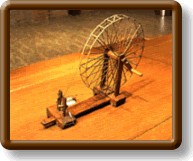 |
Age of Hand Spinning and
Weaving It is said that humans began weaving fiber to make cloth before 5000 B.C. The first fibers used were plant fibers such as flax and cotton. Later animal fibers such as wool and silk were used. Woven cloth is made from the following three basic processes. [Stomatal Opening] This is when the warp is separated into top and bottom layers. [Weft inserting] This is when the shuttle is passed through the warp. [Beating] The weft inserted yarn is beat back with the guide bar. This process does no change even when switching from a hand operated loom to a machine operated loom. |
|
|
|
| Modernization of Spinning
and Weaving Due to the Industrial Revolution It was the English industrial revolution at the beginning of the 18th century that changed spinning and weaving from a completely manual operation. In 1733, John Kay invented the flying shuttle, and in 1764, Harguripsu invented the Jenny Spinner. Then in 1820, Roberts completed the power loom, which became the basic model for modern looms thereafter. These inventions radically improved the productivity of spinning and weaving. |
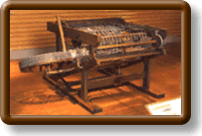 |
|
|
|
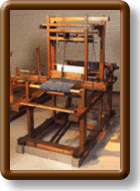 |
Import of Western European
Technology to Japan In Japan, modernization of looms was planned from around the Meiji Era. The progress of power looms in Japan took two paths. One path was to add a "pattern"(flying shuttle) unit from overseas to the conventional manual looms and then improve these by making them foot operated, etc. The other path was to import and implement Western looms. In 1858, the Satsuma domain imported water powered looms from England in order to weave sail cloth. And when the new Meiji government built the government operated Tomioka textile factory, it imported water powered looms from America. |
|
|
|
| Improvement of Manual Looms
to Make Them Power Operated In 1892, Shigejiro Matsuda perfected the foot operated loom in which two pedals were pushed alternately to continuously perform the three weaving operations and for this he received a patent. Four years later in 1896, Sakichi Toyoda invented Japan's first power loom called "the Toyoda Steam power loom". Automation continued to progress with the use of broken pick automatic stop units, warp transport units, and cloth winding units, etc. These looms were inexpensive and made of durable mixed metal and wood construction and made a major contribution to the mechanization of Japan's textile industry. Productivity was increased by twenty times and the quality of the textiles improved. |
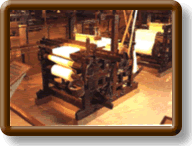 |
|
|
|
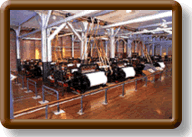 |
Vitality and Spread of Domestic
Automatic Looms During the end of the Taisho Era in 1924, a series of improvements produced a revolutionary loom. This was the continuous automatic shuttle change loom (model G automatic loom) invented by Sakichi Toyoda, which was the first of its kind in the world.This loom could automatically change the shuttle while operating at high speed without slowing down and had a unit for supplying the weft. This created a revolutionary improvement in textile quality and productivity and had a major impact on the progress of the Japanese and world textile industries.In 1929, the technology for the model G automatic loom was supplied to the English company Plat, which had earnestly sought it. Around 1925 power looms spread nationwide and exceeded the number of manual looms. |
|
|
|
| Continued Testing
in Automation After the Second World War Japan faced a serious labor shortage and the problem of strengthening international competitiveness. This led to full fledged efforts at automation. Efforts were taken to increase machine speed and improve quality. Automatic looms that use a shuttle to insert the weft began to be used to create a wide range of textiles. A series of high quality looms were developed in order to meet demand for all types of materials including silk and towel in addition to cotton materials and for a variety of forms such as small widths and wide widths thin materials and thick materials. |
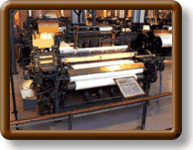 |
|
|
|
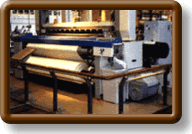 |
Increased Speed Through Introduction
of the Shuttle-less Loom After the 1960s, the goal of automatic loom manufacturers was to increase the speed of weft inserting and to reduce noise. Then a shuttle-less loom that does not use a shuttle was developed to replace the conventional shuttle loom. Methods of holding the yarn, such as the rapier loom and the gripper loom, spread rapidly. Then domestic water jet looms and air jet looms that use water or air to transport the yarn during weft insertion were produced domestically.In addition, in 1960 Japan developed the first continuous automatic spinning system. And then completely automatic spinning systems were born in the 1980s. |
|
|
|
| Implementation
of Electronic Control and Applications in Industrial Fabrics With the development of electronic technology the latest technologies, such as using computer control in automatic looms, are being used. Much development is taking place with completely automatic looms that are easy to use because only the conditions such as yarn type and weave width need to be input in order for the optimum operations to be performed. In addition to apparel and home use, the textiles created on automatic looms are also used for a variety of industrial applications. These include applications in the automobile industry, such as seat belts and airbags, in the electronics equipment sector, such as printed circuit boards, and in other sectors such as shipping, aircraft, and housing and construction. |
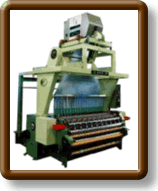 |